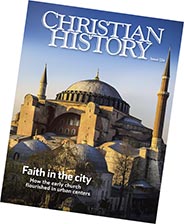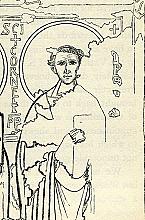Editor's note: Faith in the City
WHEN I WAS A CHILD, decades ago, it seemed that everyone I knew was moving out to the suburbs. Houses were being built in marked-off subdivisions; shopping malls were being nestled amid seas of blacktop; and churches were acquiring sprawling campuses with acres of space. (I remember how excited I was that the church my father pastored in the late 1970s had a creek on the property.)
More recently it seemed that everyone I knew was moving back to the city—in search of varied walkable communities that might make for a more engaged, less isolated lifestyle than we had found in our subdivisions.
I became a pastor at a church in the late 1990s which had just voted to remain downtown rather than move out to the suburbs. It was a radical decision then. Now it’s a decision that many churches are making. Staying in the city means being ready to respond to the needs of the city and being ready to offer Christianity in a marketplace dominated by competing distractions.
Preaching, growing, negotiating
In preaching Christ in the city, we are following in the footsteps of Christians who transformed the Roman Empire’s cities 2,000 years ago. From Jesus’ small group of early disciples, the Christian movement grew within 350 years to 56 percent of the population of the empire.
Order Christian History #124: Faith in the City in print.
Subscribe now to get future print issues in your mailbox (donation requested but not required).
Christian History has visited the early church in 11 other issues, but we’ve never talked about early Christianity specifically as an urban faith. Before Christianity was legalized, Christians had to negotiate how to live with their pagan neighbors, most of the time in cities: crowded, noisy, smelly, hedonistic cities, where they lived, worked, played, and worshiped alongside nonbelievers. In the lulls between local or empirewide persecutions, Christians held down jobs, joined the army, founded schools, created art, and bought property.
After Christianity was legalized in the third century, the church finally began to move into the countryside. But the cities continued to feel the most drastic effects as Christians built hospitals and churches, sometimes on the foundations of pagan temples they knocked down.
In this issue of CH, we’re putting the ancient “city movement” and the modern one together. In our main articles and their accompanying images of art and architecture, we’ll explore how early Christians thought, worked, prayed, obeyed, fought, served, and talked to their neighbors in cities. In a series of accompanying interviews, we’ll meet people who are doing the same things today. We’d like to thank Christianity Today’s “This Is Our City” series for alerting us to the work and witness of some of our interviewees, and the Fieldstead Foundation for a generous donation to support the production of this issue.
One of my favorite Bible passages is the image in Revelation 21–22 of the redeemed city, where the glory of the Lord is its light and the leaves of the tree there are for the healing of the nations. It’s worth remembering that it is specifically a glorious city. Something about heaven will look like a city, in all its activity and diversity, its motion and possibility. Whether you live in a large city or amid wide open spaces, we hope this issue of CH inspires you to make your home a place where the healing of the nations can begin. CH
This article is from Christian History magazine #124 Faith in the City. Read it in context here!
By Jennifer Woodruff Tait
[Christian History originally published this article in Christian History Issue #124 in 2017]
Jennifer Woodruff Tait, Managing editorNext articles
Life in the earthly city
Christians advocated for “the Way” in the middle of urban distractions much like our own
Joel C. ElowskyA bishop’s work is never done
During and after persecution, new complexities challenged church leaders
Helen Rhee“An expanding circle of love and justice”
We spoke to Katelyn Beaty, editor at large for Christianity Today, on how Christians today interact with their non-Christian neighbors.
Katelyn Beaty and the editorsHealing the city
How Christians helped the sick and poor in the Roman Empire’s cities
Gary B. FerngrenSupport us
Christian History Institute (CHI) is a non-profit Pennsylvania corporation founded in 1982. Your donations support the continuation of this ministry
Donate






